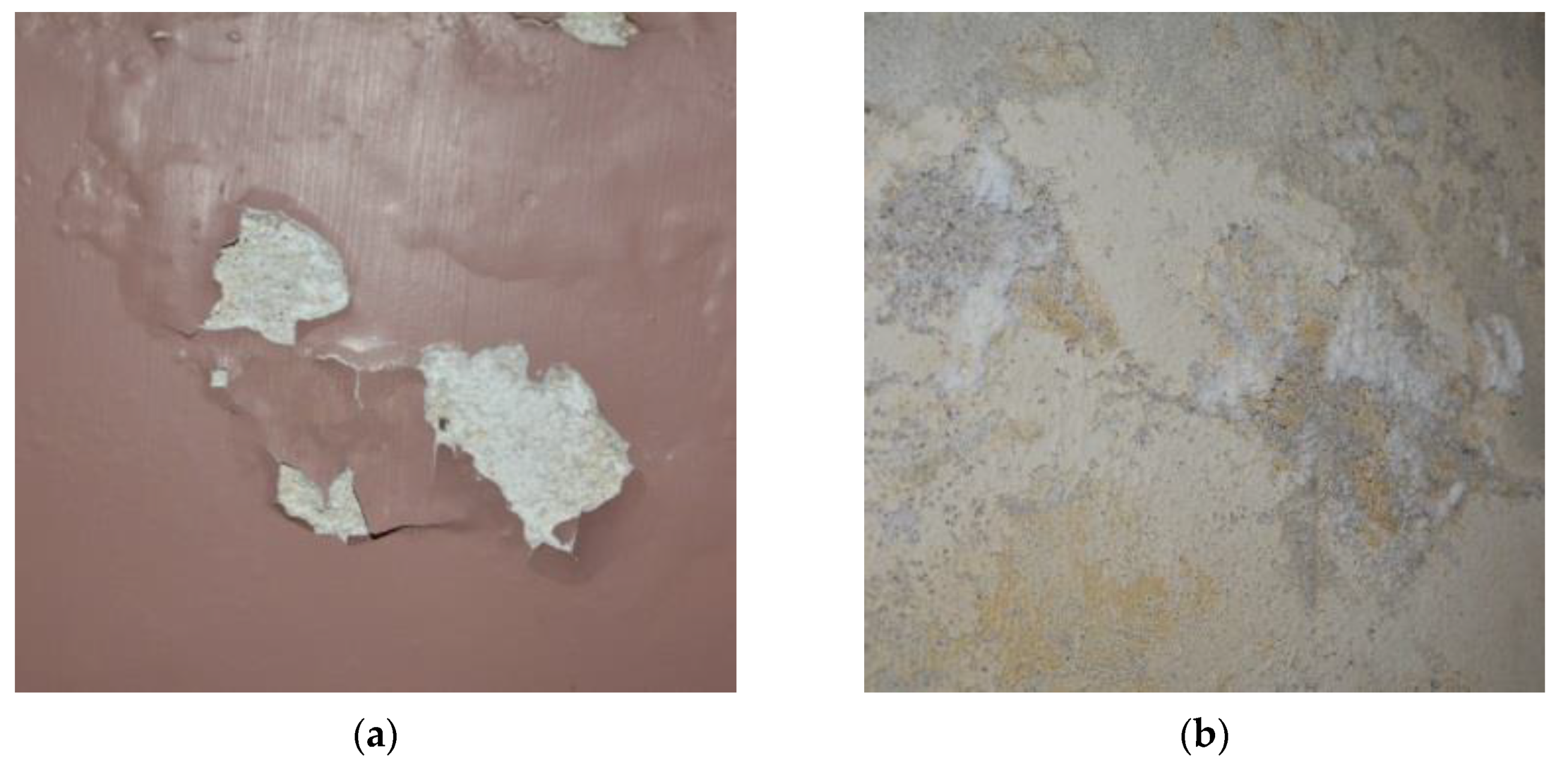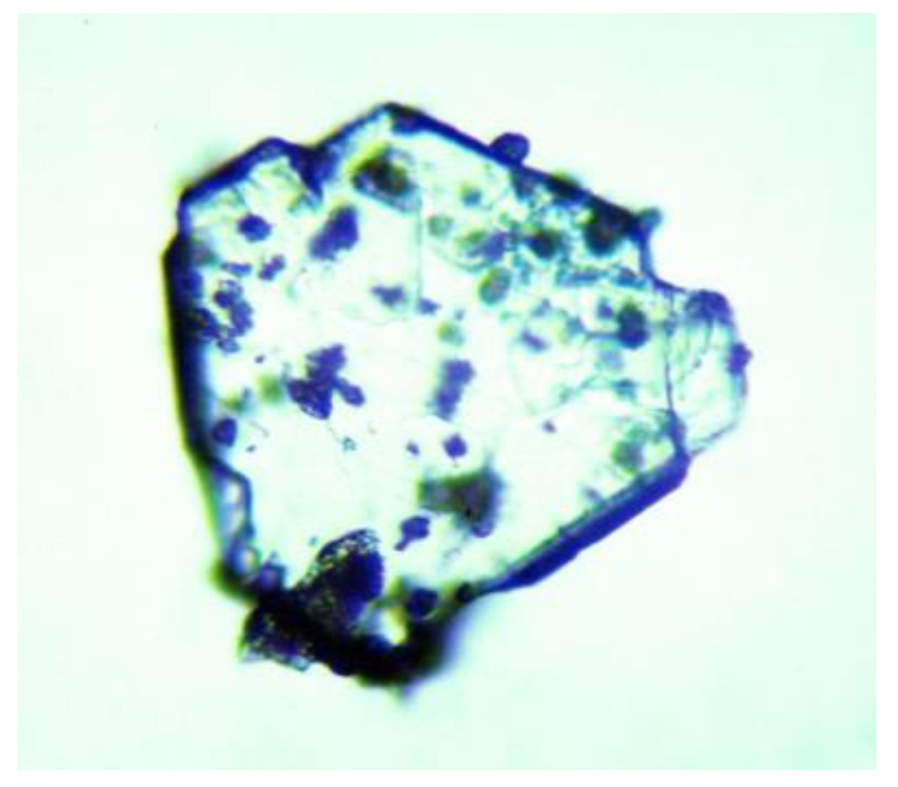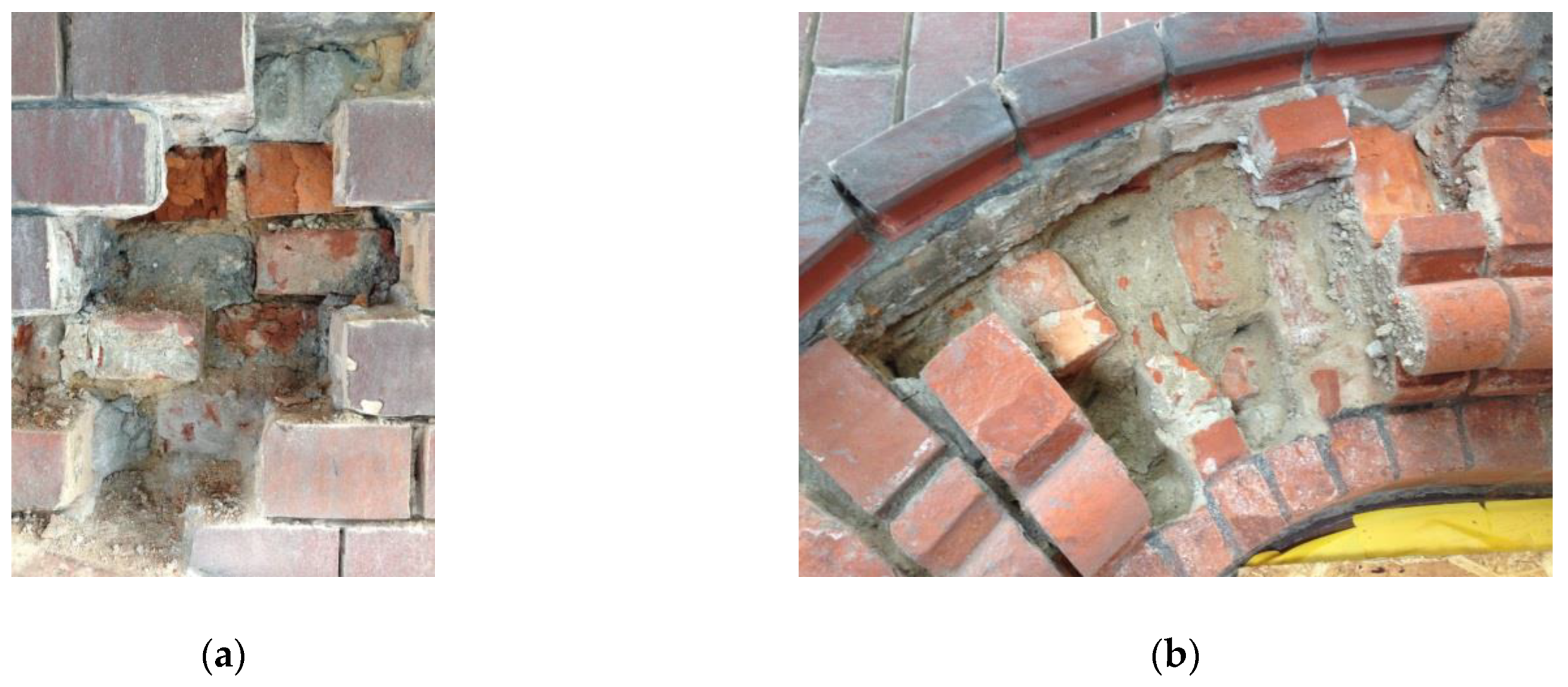Understanding Deterioration due to Salt and Ice Crystallization in Scandinavian Massive Brick Masonry
Abstract
:1. Introduction
2. Neo-Gothic Brick Architecture in Sweden
3. Finding, Recognizing and Understanding Salt and Ice Deformation in Brick Masonry
3.1. Sodium Sulphate
3.2. Black Crust from Gypsum
3.3. Chlorides
3.4. Calcium Carbonates
3.5. Ice Formation
3.6. The Behaviour of Different Salts That Cause Degradation
3.7. The Moisture Transport Phenomenon and Degradation of The Masonry Core
4. Case Studies Using Hemp-Lime as Sacrificial Plaster
4.1. ÖRgryte New Church
4.2. Test Lab in Lund
5. Discussion—What Can Be Done to Prevent Salt-Related Damage in Masonry?
- Minimising water supply from the outside;
- Adapting internal surface layers so that moisture transport can be controlled and drying can take place;
- Applying climate control measures (primarily indoors);
- The climate envelope must of course have a functioning water run-off and drainage.
- Repair of lime plaster with a dense plaster based on cement;
- Painting with latex paint on a lime plaster [4].
Results and Discussion of the Hemp-Lime Case Studies
6. Concluding Remarks
- The masonry’s behaviour in terms of absorption and evaporation, both externally and internally;
- Thermal and moisture movements, adhesion and compatibility between bricks and pointing mortars;
- Pore structure and frost resistance of porous materials;
- Minimisation of crystallization cycles on and near wall surfaces through climate control.
Author Contributions
Funding
Acknowledgments
Conflicts of Interest
References
- Paulsson, G. Hantverkets bok 4 Mureri; Lindfors: Stockholm, Sweden, 1936. [Google Scholar]
- Andersson, E. Fuktproblematik i Oputsade Sten- och tegelkyrkor i Göteborgs Stift: Projektrapport 2010; Göteborgs Stift: Gothenburg, Sweden, 2010; ISBN 978-91-978433-6-2. [Google Scholar]
- Balksten, K.; Lindholm, M.; Lange, J. Increased salt and frost damages in solid neo-Gothic brickwork masonry due to low permeable restoration materials of the 20th century. In Proceedings of the 9th International Masonry Conference, Guimarães, Portugal, 7–9 July 2014; University of Minho: Guimarães, Portugal, 2014. [Google Scholar]
- Balksten, K.; Lange, J.; Lindholm, M. Fuktproblem i Salt och Frostskadat Tegelmurverk—Fördjupad Analys av Örgryte nya Kyrka; Göteborgs Stift: Gothenburg, Sweden, 2012. [Google Scholar]
- Balksten, K. Högsäters Kyrka; Fördjupad Förundersökning av Fukt- och Saltskadat Tegelmurverk; The Church of Sweden: Munkedal, Sweden, 2017. [Google Scholar]
- Balksten, K.; Lindholm, M.; Rodin, A. Gödestads Kyrka. Förundersökning & Åtgärdsprogram för Underhåll; The Church of Sweden: Munkedal/Gothenburg, Sweden, 2018. [Google Scholar]
- Eklind, Å. Saltvittring i Äldre Tegelmurverk: Tekniska Problem och Metod att Förhindra Saltvittring; Swedish Council for Building Research [Statens råd för byggnadsforskning]: Stockholm, Sweden, 1983. [Google Scholar]
- Granholm, H. Om Vattengenomslag i Murade Väggar med Särskild Hänsyn till Tegel som Fasadmaterial; Gumpert: Gothenburg, Sweden, 1958. [Google Scholar]
- Fagerlund, G. Kritiska Vattenmättnadsgrader i Samband Med Frysning av porösa och Spröda Material; LTH, Lund University: Lund, Sweden, 1972. [Google Scholar]
- Pühringer, J. Salt Disintegration: Salt Migration and Degradation by Salt: A Hypothesis; Swedish Council for Building Research [Statens råd för byggnadsforskning]: Stockholm, Sweden, 1983; ISBN 9154040019. [Google Scholar]
- Carlsson, T. Luftporstrukturens inverkan på egenskaperna hos puts- och murbruk; Division of Building Materials, LTH, Lund University: Lund, Sweden, 1995. [Google Scholar]
- von Konow, T.; Suomenlinnan hoitokunta. The Study of Salt Deterioration Mechanisms: Decay of Brick Walls Influenced by Interior Climate Changes; Governing Body of Suomenlinna: Helsinki, Finland, 2002; ISBN 951-9437-29-0. [Google Scholar]
- Freedland, J. Soluble Salts in Porous Materials: Evaluating Effectiveness of Their Removal. Master’s Thesis, University of Pennsylvania, Philadelphia, PA, USA, 1999. [Google Scholar]
- Rodriguez-Navarro, C.; Doehne, E. Salt weathering: Influence of evaporation rate, supersaturation and crystallization pattern. Earth Surf. Process. Landf. 1999, 24, 191–209. [Google Scholar] [CrossRef]
- Rodriguez-Navarro, C.; Doehne, E.; Sebastian, E. How does sodium sulfate crystallize? Implications for the decay and testing of building materials. Cem. Concr. Res. 2000, 30, 1527–1534. [Google Scholar] [CrossRef] [Green Version]
- Flatt, R.J. Salt damage in porous materials: How high supersaturations are generated. J. Cryst. Growth 2002, 242, 435–454. [Google Scholar] [CrossRef]
- Rijniers, L.A. Salt Crystallization in Porous Materials: An NMR Study. Ph.D. Thesis, Eindhoven University of Technology, Eindhoven, The Netherlands, 2004. [Google Scholar]
- Forster, A. Binder loss in traditional mass masonry: A cause for concern? Struct. Surv. 2007, 25, 148–170. [Google Scholar] [CrossRef]
- Steiger, M.; Asmussen, S. Crystallization of sodium sulfate phases in porous materials: The phase diagram Na2SO4–H2O and the generation of stress. Geochim. Cosmochim. Acta 2008, 72, 4291–4306. [Google Scholar] [CrossRef]
- Shahidzadeh-Bonn, N.S.; Bertrand, F.; Bonn, D. Damage due to salt crystallization in porous media. arXiv 2009, arXiv:0906.2502. [Google Scholar] [CrossRef] [PubMed] [Green Version]
- Shahidzadeh-Bonn, N.; Desarnaud, J.; Bertrand, F.; Chateau, X.; Bonn, D. Damage in porous media due to salt crystallization. Phys. Rev. E 2010, 81, 066110. [Google Scholar] [CrossRef] [PubMed] [Green Version]
- Laue, S.; Schaab, C. Mitigation of salt damages by climate stabilization and salt extractions in the Crypt of St. Maria im Kapitol, Cologne. In Proceedings of the SWBSS 2011—Salt Weathering on Buildings and Stone Sculpture, Limassol, Cyprus, 19–22 October 2011; Ioannou, I., Theodoridou, M., Eds.; University of Cyprus: Nicosia, Cyprus, 2011; pp. 129–136. [Google Scholar]
- Zehnder, K.; Arnold, A. Crystal growth in salt efflorescence. J. Cryst. Growth 1989, 97, 513–521. [Google Scholar] [CrossRef]
- Scherer, G.W. Crystallization in pores. Cem. Concr. Res. 1999, 29, 1347–1358. [Google Scholar] [CrossRef]
- Lewin, S.Z. The mechanism of masonry decay through crystallization. In Conservation of Historic Stone Buildings and Monuments: Report of the Committee on Conservation of Historic Stone Buildings and Monuments; National Academies Press: Washington, DC, USA, 1982; pp. 120–144. [Google Scholar]
- Lubelli, B.; De Rooij, M.R. NaCl crystallization in restoration plasters. Constr. Build. Mater. 2009, 23, 1736–1742. [Google Scholar] [CrossRef]
- Granneman, S.J.; Lubelli, B.; Van Hees, R.P. Mitigating salt damage in building materials by the use of crystallization modifiers—a review and outlook. J. Cult. Herit. 2019, 40, 183–194. [Google Scholar] [CrossRef]
- Lubelli, B.; Cnudde, V.; Diaz-Goncalves, T.; Franzoni, E.; Van Hees, R.P.J.; Ioannou, I.; Menendez, B.; Nunes, C.; Siedel, H.; Stefanidou, M.; et al. Towards a more effective and reliable salt crystallization test for porous building materials: State of the art. Mater. Struct. 2018, 51, 55. [Google Scholar] [CrossRef]
- Koniorczyk, M.; Konca, P. Experimental and numerical investigation of sodium sulphate crystallization in porous materials. Heat Mass Transf. 2012, 49, 437–449. [Google Scholar] [CrossRef] [Green Version]
- Espinosa-Marzal, R.M.; Scherer, G.W. Advances in understanding damage by salt crystallization. Acc. Chem. Res. 2010, 43, 897–905. [Google Scholar] [CrossRef]
- Koniorczyk, M.; Gawin, D.; Schrefler, B.A. Multiphysics model for spalling prediction of brick due to in-pore salt crystallization. Comput. Struct. 2018, 196, 233–245. [Google Scholar] [CrossRef]
- La Iglesia, A.; González, V.; Lopez-Acevedo, V.; Viedma, C. Salt crystallization in porous construction materials. 1. Estimation of crystallization pressure. J. Cryst. Growth 1997, 177, 111–118. [Google Scholar] [CrossRef] [Green Version]
- Coussy, O. Deformation and stress from in-pore drying-induced crystallization of salt. J. Mech. Phys. Solids 2006, 54, 1517–1547. [Google Scholar] [CrossRef]
- Koniorczyk, M.; Gawin, D. Modelling of salt crystallization in building materials with microstructure—Poromechanical approach. Constr. Build. Mater. 2012, 36, 860–873. [Google Scholar] [CrossRef]
- Espinosa, R.; Franke, L.; Deckelmann, G. Model for the mechanical stress due to the salt crystallization in porous materials. Constr. Build. Mater. 2008, 22, 1350–1367. [Google Scholar] [CrossRef]
- Benavente, D.; Linares-Fernández, L.; Cultrone, G.; Sebastián, E. Influence of microstructure on the resistance to salt crystallisation damage in brick. Mater. Struct. 2006, 39, 105–113. [Google Scholar] [CrossRef]
- Hendrickx, R.; De Clercq, H.; Roels, S.; Vanhellemont, Y.; Herinckx, S. Experimental investigation of the influence of precipitated salts on the liquid transport properties of brick using an organic fluid. In Proceedings of the SWBSS 2011, Limassol, Cyprus, 19–22 October 2011; pp. 55–62. [Google Scholar]
- Stryszewska, T.; Matysek, P.; Kańka, S.; Witkowski, M. The influence of water saturation on mechanical properties of ceramic bricks—tests on 19th century and contemporary bricks. Mater. Construcción 2016, 66, e095. [Google Scholar] [CrossRef] [Green Version]
- Stryszewska, T.; Kanka, S. The effects of salt crystallization in ceramic bricks in terms of line deformations. In Proceedings of the International Conference on Analystical Models and new Concepts in Concrete and Masonry Structures, Gliwice, Poland, 5–7 June 2017; Kubica, J., Ed.; Elsevier Procedia Engineering: Amsterdam, The Netherlands, 2017; Volume 193, pp. 120–127. [Google Scholar]
- Arizzi, A.; Viles, H.A.; Cultrone, G. Experimental testing of the durability of lime-based mortars used for rendering historic buildings. Constr. Build. Mater. 2012, 28, 807–818. [Google Scholar] [CrossRef]
- Fagerlund, G. Critical Degrees of Saturation at Freezing of Porous and Brittle Materials. Ph.D. Thesis, Lund University, Lund, Sweden, 1973. [Google Scholar]
- Fagerlund, G. Significance of Critical Degrees of Saturation at Freezing of Porous and Brittle Materials: Contribution to ACI-Symposium Durability of Concrete, Ottawa October 1973; Former Dept of Building Technology [Tid. Institutionen för byggnadsteknik] LTH, Lund University: Lund, Sweden, 1973. [Google Scholar]
- Koniorczyk, M.; Gawin, D.; Schrefler, B.A. Modeling evolution of frost damage in fully saturated porous materials exposed to variable hygro-thermal conditions. Comput. Methods Appl. Mech. Eng. 2015, 297, 38–61. [Google Scholar] [CrossRef]
- Stryszewska, T.; Kańka, S. Forms of damage of bricks subjected to cyclic freezing and thawing in actual conditions. Materials 2019, 12, 1165. [Google Scholar] [CrossRef] [Green Version]
- Balksten, K. Traditional Lime Mortar and Plaster: Reconstruction with Emphasis on Durability. Ph.D. Thesis, Chalmers University of Technology, Gothenburg, Sweden, 2007. [Google Scholar]
- von Konow, T. Restaurering och Reparation Med Puts- och Murbruk; Åbo Akademi: Åbo, Finland, 1997; ISBN 9529616791. [Google Scholar]
- Desarnaud, J.; Bonn, D.; Shahidzadeh, N. The pressure induced by salt crystallization in confinement. Sci. Rep. 2016, 6, 30856. [Google Scholar] [CrossRef] [PubMed] [Green Version]
- Grementieri, L.; Molari, L.; Derluyn, H.; Desarnaud, J.; Cnudde, V.; Shahidzadeh, N.; De Miranda, S. Numerical simulation of salt transport and crystallization in drying Prague sandstone using an experimentally consistent multiphase model. Build. Environ. 2017, 123, 289–298. [Google Scholar] [CrossRef]
- Lindström, N.; Heitmann, N.; Linnow, K.; Steiger, M. Crystallization behavior of NaNO3–Na2SO4 salt mixtures in sandstone and comparison to single salt behavior. Appl. Geochem. 2015, 63, 116–132. [Google Scholar] [CrossRef]
- Franković, M.; Novaković, N.; Erić, S.; Vulić, P.; Matović, V. Investigation of salts sources at the Karadjordje’s Gate on the Belgrade Fortress. In Proceedings of the SWBSS 2017, Potsdam, Germany, 20–22 September 2017; Laue, S., Ed.; Verlag der Fachhochschule Potsdam: Potsdam, Germany, 2017; pp. 252–260. [Google Scholar]
- Golež, M.; Siedel, H.; Drnovšek, S. Attack of marine salts on the church of St. Mary of Health in Piran, Slovenia: Material deterioration and conservation strategies. In Proceedings of the SWBSS 2011, Limassol, Cyprus, 19–22 October 2011; pp. 137–144. [Google Scholar]
- Madureira, M.C.V.; Begonha, A. Salt weathering in the Monastery of Serra do Pilar in Vila Nova de Gaia, Portugal. In Proceedings of the SWBSS 2011, Limassol, Cyprus, 19–22 October 2011; pp. 121–128. [Google Scholar]
- Török, Á.; Galambos, É.; Józsa, Z.; Kriston, L.; Bóna, I.; Csányi, E.; Szemerey-Kiss, B.; Méreyné-Bán, B. Salt efflourescence and subfluorescence in Baroque frescos and the role of bat droppings in the decay wall paintings. In Proceedings of the SWBSS 2011, Limassol, Cyprus, 19–22 October 2011; pp. 97–104. [Google Scholar]
- Desarnaud, J.; Bertran, F.; Shahidzadeh-Bonn, N. Dynamics of salt crystallization. In Proceedings of the SWBSS 2011, Limassol, Cyprus, 19–22 October 2011; pp. 23–30. [Google Scholar]
- Eriksson, A. Murtegel och Tegelmurverk ur Byggnadsteknisk Synpunkt; Swedish Brick Industry Association [Sveriges tegelindustriförening]: Stockholm, Sweden, 1932. [Google Scholar]
- Balksten, K.; Mebus, U. Bruk av Ruiner—Kulturarv, Konstruktion, Kalkbruk, Komfort och Kalsonger; Fornsalens Förlag, Gotlands Museum: Visby, Sweden, 2012. [Google Scholar]
- Balksten, K.; Strandberg-de Bruijn, P.B. Hampakalk: Tilläggsisolering på Reveterade Trähus och Saltskadat Tegelmurverk: Research Report 2019; Lund University: Lund, Sweden, 2019; ISBN 9789178950348. [Google Scholar]
- von Rothstein, E. Allmänna Byggnadsläran; Beijers förlag: Stockholm, Sweden, 1890. [Google Scholar]
- Stål, C. Utkast till Allmän Byggnadslära. Fahlun, Sweden. 1854. Available online: https://gupea.ub.gu.se/handle/2077/41760 (accessed on 11 February 2021).
- Henström, A. Praktisk Handbok i Landtbyggnads-Konsten: Innefattande Läran om Byggnadsmaterialierna, Bygnadsmaterialiernas Bearbetning och Sammanfogning, Byggnadsdelarnes Form, Dimensioner och Styrka; Beijer: Örebro, Sweden, 1869. [Google Scholar]
- Maes, M.; De Belie, N. Resistance of concrete and mortar against combined attack of chloride and sodium sulphate. Cem. Concr. Compos. 2014, 53, 59–72. [Google Scholar] [CrossRef]
- Price, C.; Brimblecombe, P. Preventing salt damage in porous materials. Stud. Conserv. 1994, 39, 90–93. [Google Scholar] [CrossRef]
- Burström, P.G.; Nilvér, K. Byggnadsmaterial—Tillverkning, Egenskaper och Användning, 3rd ed.; Studentlitteratur AB: Lund, Sweden, 2018. [Google Scholar]
- Verney-Carron, A.; Saheb, M.; Ben Amor, Y.; Balland, C. Correlation between Black Crust Formation on Limestone Monuments and Air Pollution; hal-02277446, Barcelone, France; Available online: https://hal.archives-ouvertes.fr/hal-02277446 (accessed on 11 February 2021)2019.
- Graue, B.; Siegesmund, S.; Simon, K.; Licha, T.; Oyhantcabal, P.; Middendorf, B. Environmental impact on stone decay: Crust formation at the Cologne Cathedral. In Proceedings of the 12th International Congress on the Deterioration and Conservation of Stone, New York, NY, USA, 21–25 October 2012. [Google Scholar]
- Tsui, N.; Flatt, R.J.; Scherer, G.W. Crystallization damage by sodium sulfate. J. Cult. Herit. 2003, 4, 109–115. [Google Scholar] [CrossRef]
- Grahn Andersson, A. Salter i Porösa Oorganiska Byggnadsmaterial. Bachelor Thesis, Högskolan på Gotland, Visby, Sweden, 2008. [Google Scholar]
- Klenz Larsen, P. Desalination of Painted Bick Vaults. Ph.D. Thesis, Technical University of Denmark, Kongens Lyngby, Denmark, 1999. [Google Scholar]
- Schwarz, H.-J. Salt Wiki. Available online: www.saltwiki.net (accessed on 1 March 2020).
- López-Acevedo, V.; Viedma, C.; Gonzalez, V.; La Iglesia, A. Salt crystallization in porous construction materials. 2. Mass transport and crystallization processes. J. Cryst. Growth 1997, 182, 103–110. [Google Scholar] [CrossRef] [Green Version]
- Camuffo, D.; Bertolin, C.; Amore, C.; Bergonzini, A.; Brimblecombe, P. Thenardite-Mirabilite cycles in historical buildings. In Proceedings of the 9th Indoor Air Quality Meeting, Chalon-Sur-Saone, France, 21–23 April 2010. [Google Scholar]
- Broström, T.; Leijonhufvud, G. The Indoor Climate in Skokloster Castle. In Historical Buildings as Museums: Systems for Climate Control and Heritage Preservation; Nardini Editore: Florence, Italy, 2010; pp. 84–93. [Google Scholar]
- Kjellin, E.; Hökerberg, O. Byggnadskonsten, dess Teori, Juridik och Praktik; Hökerberg: Stockholm, Sweden, 1928. [Google Scholar]
- Kreüger, H. Om Murbruk och Tegelmurverk; Tekniskt Bibliotek: Stockholm, Sweden, 1916. [Google Scholar]
- De Bruijn, P.; Johansson, P. Moisture fixation and thermal properties of lime–hemp concrete. Constr. Build. Mater. 2013, 47, 1235–1242. [Google Scholar] [CrossRef]
- Collet, F.; Pretot, S. Thermal conductivity of hemp concretes: Variation with formulation, density and water content. Constr. Build. Mater. 2014, 65, 612–619. [Google Scholar] [CrossRef] [Green Version]
- Gourlay, E.; Glé, P.; Marceau, S.; Foy, C.; Moscardelli, S. Effect of water content on the acoustical and thermal properties of hemp concretes. Constr. Build. Mater. 2017, 139, 513–523. [Google Scholar] [CrossRef]
- Page, J.; Sonebi, M.; Amziane, S. Design and multi-physical properties of a new hybrid hemp-flax composite material. Constr. Build. Mater. 2017, 139, 502–512. [Google Scholar] [CrossRef] [Green Version]
- Arnaud, L.; Gourlay, E. Experimental study of parameters influencing mechanical properties of hemp concretes. Constr. Build. Mater. 2012, 28, 50–56. [Google Scholar] [CrossRef]
- Collet, F.; Bart, M.; Serres, L.; Miriel, J. Porous structure and water vapour sorption of hemp-based materials. Constr. Build. Mater. 2008, 22, 1271–1280. [Google Scholar] [CrossRef]
























| Name | Chemical Formula | Critical RH for Crystallization at 20 °C [%] | Solubility [g/L] | Molar Mass [g/molar] |
|---|---|---|---|---|
| halite | NaCl | 75 | 360 | 58.5 |
| thenardite | Na2SO4 | 82 | 162 | 142 |
| mirabilite | Na2SO4·10H2O | 91 | 900 | 322 |
| gypsum/ettringite | CaSO3·2H2O | ~100 | 2.4 | 172 |
| lime/calcite | CaCO3 | ~100 | 14·× 10−3 | 100 |
Publisher’s Note: MDPI stays neutral with regard to jurisdictional claims in published maps and institutional affiliations. |
© 2021 by the authors. Licensee MDPI, Basel, Switzerland. This article is an open access article distributed under the terms and conditions of the Creative Commons Attribution (CC BY) license (http://creativecommons.org/licenses/by/4.0/).
Share and Cite
Balksten, K.; Strandberg-de Bruijn, P. Understanding Deterioration due to Salt and Ice Crystallization in Scandinavian Massive Brick Masonry. Heritage 2021, 4, 349-370. https://doi.org/10.3390/heritage4010022
Balksten K, Strandberg-de Bruijn P. Understanding Deterioration due to Salt and Ice Crystallization in Scandinavian Massive Brick Masonry. Heritage. 2021; 4(1):349-370. https://doi.org/10.3390/heritage4010022
Chicago/Turabian StyleBalksten, Kristin, and Paulien Strandberg-de Bruijn. 2021. "Understanding Deterioration due to Salt and Ice Crystallization in Scandinavian Massive Brick Masonry" Heritage 4, no. 1: 349-370. https://doi.org/10.3390/heritage4010022
APA StyleBalksten, K., & Strandberg-de Bruijn, P. (2021). Understanding Deterioration due to Salt and Ice Crystallization in Scandinavian Massive Brick Masonry. Heritage, 4(1), 349-370. https://doi.org/10.3390/heritage4010022






